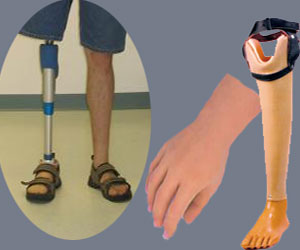About
Artificial limbs, prosthetic limbs or prostheses are mechanical replacements for missing limbs –arms or legs. When people have the misfortune of losing their arms or legs due to injury, disease or birth defects,
An upper extremity amputation that might result in the loss of the entire arm or a part of it could leave a person ill equipped to perform day to day activities involving the arm such as washing, writing, typing, hugging, lifting objects and so on. Similarly, a lower extremity amputation will have a person missing the whole or a portion of the leg and this could render the person incapable of walking, running and performing other activities involving the lower limbs. Artificial limbs are devised to afford better mobility involving limbs and give people the freedom of functioning without depending on others.

Artificial limbs are of two types- Exoskeletal or Crustacean and Endoskeletal or modular. The Exoskeletal variety has a hard and rigid shell because the walls of the artificial limbs are responsible for the shape as well as the weight transmission. In the endoskeletal type a central shaft covered by a cosmetic covering is used to transmit weight.
Artificial limbs are named according to the level of amputation performed to fit the limbs. The four main names for artificial limbs are:
- Transtibial- the artificial limb that replaces the missing part of leg below the knee
- Transfemoral- the artificial limb above the knee
- Transradial- the artificial limb that replaces the arm below the elbow
- Transhumeral- the artificial limb above the elbow
Modern day artificial limbs have moved a long way from the peg legs and cumbersome iron and wooden replacements for missing limbs used in olden days. Advanced surgical procedures enable precise amputations to fit appropriately devised artificial limbs. Lighter materials and improved computer aided designs in artificial limbs along with laser assisted measuring and fitting of the limbs, afford greater degree of flexibility and maneuverability for the user these days.
Ideally artificial limbs must be light, flexible and easily adaptable to the user to permit easy movement. It should also be strong enough to support the body’s weight if they are artificial legs or feet and manipulate objects if they are artificial arms or hands or parts of the same. Artificial limbs basically need to be functional, comfortable, afford a great degree of stability, be cosmetically acceptable, not too expensive, readily available and serviceable and preferably local for quick repairs and adjustments. Artificial limbs are usually made out of materials like willow wood, metallic alloys, fiber and plastic lamination and complex carbon –fiber substances.
Artificial limbs are not manufactured in bulk but most often custom made to suit individual needs. After initial consultation with the amputee, a prosthetist (healthcare professional skilled in making and fitting artificial limbs) and a physiotherapist, a medical doctor prescribes artificial limbs to the amputee. Following the prescription, the person visits the prosthetist to have the artificial limb fitted. Before making the artificial limb the prosthetist evaluates the amputee and takes a digital reading or at least an impression of the remaining part of the natural limb. Computers using a CAD/CAM to design artificial limbs and laser guided measuring and fitting have vastly improved the quality of artificial limbs available for amputees.
The cost of fitting artificial limbs depends on the materials used and the degree of sophistication involved in customizing the product to the user. Depending upon wear and tear, and also if the person gains or loses weight, the artificial limb may have to be replaced once in every 3 or 4 years. While there are artificial limbs that cost over $8000 a piece there are also well designed, low cost, functional ones like the popular Jaipur foot manufactured in India.
 MEDINDIA
MEDINDIA
 Email
Email
I have lost my left leg in accident and its got amputed from knee. I am going to put artificial leg but I am confused wheter I can bend my leg from knee because I have got amputed from knee, I mean just exactly from knee
One of my brother lost his leg in an accident so he needs artificial limbs, I really found good information to help my brother...
Dear sir, This comment for my brother in law he lost his leg below the knee [ some portion is there in below knee ] in road accident recently. He is under treatment for fixing artificial leg, how long will take time and how much will be cost.
Dear sir i have lost my right hand in an accident. So i can replace it with artificial hand. D don't know about the whole process so can you suggest about all. Pls help me. As soon as possible....
Sir My son lost left hand from elbow in papad machine at 4 year old. Kindly give the new artificial working hand so he can do his work in both hand and drive vehicle.
Dear Mr. Sanjay,
We offer Complete Rehab facility associated with fitting and training of various Prosthesis including Myoelectric Upper limb Systems and Microprocessor controlled Lower Limb Systems.
Consult Orthopedic Doctor Online
Dr. Padmaja Uppala
MBBS, FID, MS
17 years experience
Medi Clinic, Tirupati
Dr. Nigil Sadanandan Palliyil
MBBS, MS, DNB, FNB, Senior Clinical Fellowship
8 years experience
Amrita Hospital, Ernakulam
Dr. Soham Patel
MBBS, MS
11 years experience
Sai Orthopedic Hospital, Modasa road, Lunawada
Dr. Aswin Thankachan V
MBBS, MS, FASM
12 years experience
What's New on Medindia
Articles
Follow @MedIndia
Artificial Limbs - Related News